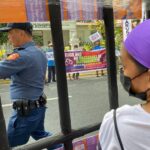by Walden Bello, the Nation Newspaper, 18 March, 1997, Bangkok, Thailand
With leaks at reactors, rising costs of building plants and a huge stockpile of weapon-grade plutonium, Japan’s nuclear energy plan raises the question of regional security, Walden Bello comments.
Last week’s explosion at the Tokaimura reprocessing plant in Japan, which released extremely toxic plutonium and exposed about 35 workers to ”low-level” radiation, has again focused attention on that country’s controversial plutonium programme.
Not only has it exponentially raised the numbers of people opposed to the whole nuclear energy programme; it has also forcefully reminded Japan’s neighbours that Japan is building up a plutonium stockpile that could potentially be diverted to military uses.
The Ultimate Technofix
The plutonium programme is probably the ultimate technofix.
Sold to the Japanese public in the 1960s as the lasting solution to the island country’s perennial insecurity about its energy supplies, it seemed, in the wake of the massive Opec price hikes of 1973 and 1979, terribly prescient.
The first element in the programme was to build a couple of fastbreeder reactors (FBRs) that would lo and behold be practically self-sufficient because they would extract plutonium fuel, the very fuel they consumed.
The second element was constructing a couple of reprocessing facilities that would extract plutonium from the spent uranium fuel from the country’s 48 conventional nuclear reactors.
That residual could then be available as fresh fuel either for the FBRs or as an ingredient in a special fuel (MOX) for refitted conventional light-water reactors (LWR).
The Tokaimura plant was the first of a couple of planned reprocessing plants.
The only problem with this grandiose energy strategy was that the FBRs and the reprocessing plants would deal with plutonium, which is not only extremely toxic but is also the key ingredient in the manufacture of nuclear weapons.
Following the accidents at Three Mile Island and Chernobyl, Japan’s plutonium programme came under increasing public criticism along with its conventional light-water reactor (LWR) programme.
This was not helped by the spectacle of long-distance shipments of plutonium fuel from France for the projected fastbreeders and refitted conventional reactors, which spawned possible scenarios of either disaster at sea or hijacking of the shipments by terrorists.
But Japan’s nuclear bureaucracy sailed through these problems, until an accident hit Japan’s first power-generating FBR in Monju in mid-December 1995.
While the accident did not involve a major radiation release, it was nevertheless serious.
Some 700 kilograms of sodium leaked and violently interacted with oxygen and water in the ambient air to produce a fire that damaged pipes and ducts.
Delayed reaction by the operators, who failed to trip the reactor immediately, showed an appalling lack of ability to manage an emergency involving an extremely sensitive technology.
A cover-up intended to downplay the seriousness of the accident and a suicide by a member of th nuclear plant’s in-house investigating team compounded the shock of the Japanese public.
Now, with Monju still fresh in the mind of the Japanese public comes the far more serious Tokaimura explosion the details of which still have to be fully revealed. Also, concerns about escalating cost estimates are undermining the programme.
Cost inflation is associated with another key component of the programme: The planned Rokkasho reprocessing facility, a much bigger plant than the Tokaimura plant which is meant to reduce dependence on European reprocessing.
In 1996, the government revealed that building Rokkasho would cost about 1.88 trillion yen, or some US$1.6 billion (Bt40 billion) twice the initial estimate and some six to seven times more than the cost of European reprocessing plants of a similar size.
This combination of accidents and escalating costs has generated a lot of domestic opposition to the programme, making it unlikely that either Tokaimura or Monju will be restarted soon, or that another projected FBR will, in fact, be built.
This domestic opposition, in turn, is now being articulated with foreign opposition that is building up owing to the erosion of Japan’s declared policy on its plutonium stockpile.
The Japanese government has a ”no plutonium stockpile” policy, that is, it seeks, ostensibly, to keep the supply and demand of plutonium in balance so as to assure Japan’s neighbours that it has no intention of using the plutonium to make nuclear weapons.
But with the FBR programme dead in the water, this has left the Japanese government with no other option but to use up its plutonium stock by mixing it with uranium and burning the combination, known as MOX, in LWRs, of which there are about 48 in operation.
The problem is that long delays are expected in refitting and relicencing LWRs to burn MOX, owing to strong local opposition in the communities where the reactors are located. Indeed, in many cases, it will be hard to overcome citizen resistance. The upshot is that Japan now has a de facto surplus of plutonium.
This surplus is estimated by Dr Jinzaburo Takagi, one of the Japan’s foremost authorities on the plutonium programme, to have risen from 8.9 tonnes in 1993 to 11.6 tonnes in 1994.
The surplus is expected to exceed 30 metric tonnes by 2000 and 70 tonnes by 2010.
Despite the crisis of the FBR programme and the embarrassing rise in the plutonium stockpile, the Japanese bureaucracy is still committed to the use of plutonium as a key part of its energy policy.
Not surprisingly, this bureaucratic stubbornness has increasingly raised suspicions both inside and outside Japan.
Doubts about whether the plutonium policy might not be, in some way, connected to a security policy that intends to ”keep the nuclear option open”.
The scenario in some people’s minds is that the security situation in East Asia is becoming more complex.
Japan might at some point depart from the US-Japan security treaty as the key pillar of its defence and move over towards a more independent defence policy. This in itself is not seen in progressive circles as a bad development.
However, an independent Japanese security policy might not go in the direction of anchoring the defence of the country in a multilateral peace and security system, as people on the left prefer.
But in a neo-nationalist course of developing a strong military capability, with a nuclear component.
Is There a Weapons Connection?
Dr Takagi and other critics of the plutonium programme are skeptical that the plutonium surplus is the result of a bureaucratic conspiracy to preserve the nuclear option.
However, they strongly urge the scrapping of the plutonium programme for two reason.
First, it is creating anxiety among Japan’s neighbours, particularly North Korea, South Korea and China, about Japanese intentions, tempting them, for defensive reasons, to consider undertaking plutonium reprocessing programmes of their own.
Second, while strong domestic sentiment against nuclear weapons currently exists, one cannot assume this will always be so.
Should political conditions change and the right-wing becomes dominant, a plutonium supply will be available for the manufacture of nuclear weapons.
But does Japan have the capability to make nuclear weapons? There is now little doubt that the technological capability is there.
In fact, a recent high level study conducted by the Russian government has concluded that Japan is capable of making nuclear weapons 20 days to two months after the political decision to do so is taken.
Scrapping the plutonium policy, it is becoming clear, is a necessity not only for environmental and health reasons but in order to ease tensions in the conflict-ridden Northeast Asian region.
Walden Bello, a Nation contributing editor, is co-director of Focus on the Global South, a programme of Chulalongkorn University; a professor of sociology and public administration at the University of the Philippines; and the author of several books on peace and security in the Asia-Pacific. This is the first of a series on Asia-Pacific security.







